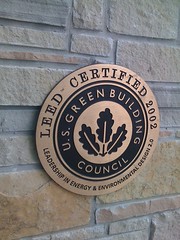
Space planners have traditionally kept matters like budget, intended use, and scale in mind when designing the interior of a new building. But today – with decision makers increasingly concerned about the environmental impact of the depletion of raw materials and generation of waste – design professionals are adding these considerations to the planning process. The key measurement of a project’s environmental success is its LEED Certification.
What Is LEED Certification?
Leadership in Energy and Environmental Design (LEED) is a rating system developed by the U.S. Green Building Council in 1993. At present count, there are over 7,000 projects in the U.S. and abroad recognized as achieving a ratings status for the design, construction, and operation of high performance buildings. The LEED system was created to define a standard of excellence and encourage sustainable building practices.
As green building technologies have advanced through the years, the LEED rating system has evolved, too. Buildings may range from the baseline “Certified” designation up to Platinum, based on a points accrual system. Green design categories like Energy and Atmosphere, Materials and Resources, and Indoor Environmental Quality are considered when LEED Accredited Professionals or Green Associates assess credits for a project.
The Benefits of A LEED Certified Project
For facilities managers, building designers, and real estate developers, attaining LEED certification for a project may bring immediate financial benefits. Several case studies suggest that LEED-certified office spaces, for example, have higher occupancy rates and command premium rent. While initial investments in materials and processes may exceed those used in more conventional construction, costs over time are mitigated by lower-than-industry standard operating expenses like heating and cooling.
Other, less tangible benefits include gains in employee productivity due to a more regulated, healthier environment and public relations advantages stemming from an eco-friendly corporate image. And over the long term, economic incentives available from state and local governments can help reduce total cost of ownership through tax credits, tax breaks, density bonuses, reduced fees, priority or expedited permitting, grants and low-interest loans.
LEED Certification and Your Design Project
For design teams planning LEED projects, form and function are joined by eco-friendly approaches. Attractive, high performance and environmentally sustainable digital signage technologies, like NanoLumens products, provide the ideal solution to an organization pursuing LEED certification. In addition to the lower energy requirements of LED (vs. LCD), NanoLumens displays are made of at least 50% reclaimed materials and are almost completely recyclable.
When planning your next commercial renovation or new construction, consider pursuing LEED certification for the short- and long-term benefits. Demonstrate your commitment to the environment by using energy-efficient products or those made from reclaimed materials. This route could help the project earn valuable credits toward attaining certification.
